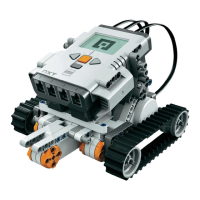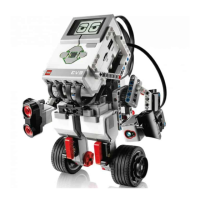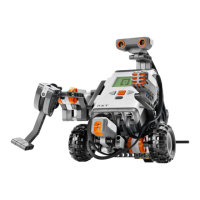Page 141
grab
turnAround
return
release
turnAround
;
I won't describe every word in Minerva's program, but I do want to cover the more interesting ones. First, let's take a look at seek and return. The interesting thing about seek is that it uses
one of the RCX's timers to figure out how long Minerva moves forward before finding something to pick up. Timer 1 is used for this purpose; the sleep word uses timer 0. seek first sets timer
1 to 0 like this:
0 1 TIMER_SET
Then Minerva moves forward until she "sees" something to pick up. The current timer value is recorded in a variable, returnTime, like this:
1 TIMER_GET returnTime !
When it's time for Minerva to drive back to her starting point, in returnTime, we just need to drive back for the stored amount of time:
: return
forward
returnTime @ sleep
stop
;
Another interesting word is calibrate, which takes ten readings of the light sensor and calculates an average value. This value is used to determine if the light sensor "sees" something that can
be picked up or not. We begin by pushing the current running total on to the stack. To begin with, the total is zero:
: calibrate
0
Then we just run in a loop from 0 to the constant value NUMBER_OF_SAMPLES. Each time through the loop, we read the value of input 3 and add it to the running total on the stack. This is done
every tenth of a second, by calling 1 sleep:
NUMBER_OF_SAMPLES 0 DO
2 sensorValue +
1 sleep
LOOP
Once this is done, calculating an average is a simple matter of division:
NUMBER_OF_SAMPLES /
Then the average value is stored in the threshold variable:
threshold !

